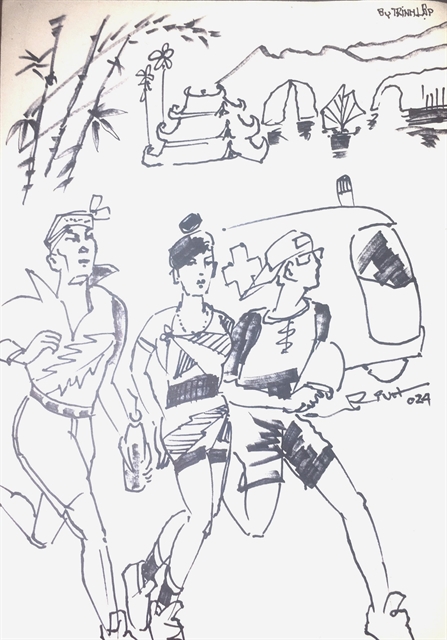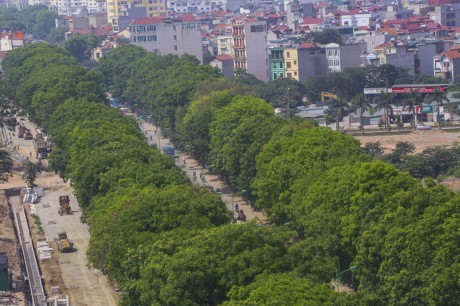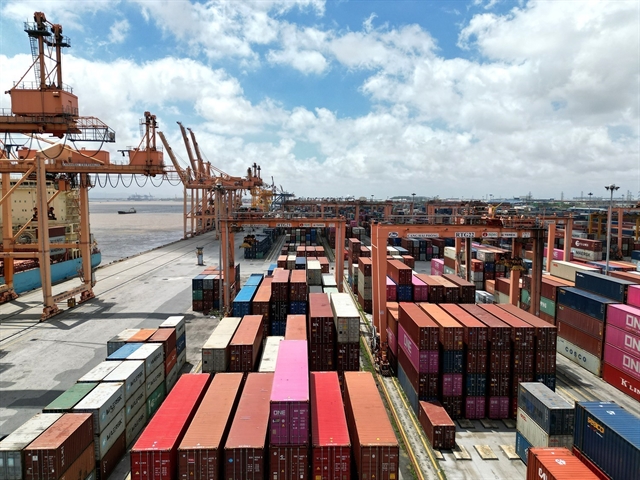 Talk Around Town
Talk Around Town

Up to 1,300 trees, planted in the 1980s along Phạm Văn Đồng Street in Hà Nội’s western area, will be chopped down to broaden the street and build a bridge on Belt Road No 3, connecting areas of Mai Dịch and Nam Thăng Long.
 |
| Up to 1,300 trees, planted in the 1980s along Phạm Văn Đồng Street in Hà Nội’s western area, will be chopped down to broaden the street and build a bridge on Belt Road No 3, connecting areas of Mai Dịch and Nam Thăng Long. |
by Nguyễn Hằng
Last weekend, Hanoians experienced the worse heat wave recorded in four decades, with the highest temperature reaching 41.5 degrees Celsius. The "real feel" was much higher. Two people died of heat stroke; thousands of elderly people and children were hospitalized.
But what was getting the capital’s residents even hotter was the news that up to 1,300 trees, planted in the 1980s along Phạm Văn Đồng Street in Hà Nội’s western area, were about to be chopped down to broaden the street and build a bridge on Belt Road No 3, connecting areas of Mai Dịch and Nam Thăng Long. The project, costing more than VNĐ5.3 trillion ($235 million), is scheduled to start in the third quarter of this year and finish in the fourth quarter of 2019.
Lê Hoàn, a resident of Long Biên District, said it took only several years to construct a bridge but it took over 30 years to grow the trees. “Why do they propose to chop down the trees? I’m deeply disappointed,” he said.
Phạm Tú Anh of Hai Bà Trưng District said that even as the weather was becoming more severe due to climate change and urbanization, authorities are planning to cut down so many trees. "Please, stop," she said.
In an article in Sức khỏe đời sống (Health and Life) newspaper, Associate Professor Nguyễn Huy Nga, former head of the Environment Management Department under the Ministry of Health, wrote that trees played a very important role in urban areas.
Research from Singapore and the United States show that temperatures in leafy cities could be 4 degrees Celsius lower, dust could be reduced by 13 per cent and 12 per cent of energy consumption saved, he added.
According to a study by Michigan State University’s Urban Forestry, the presence of trees helps curb air pollution by 30 per cent. An adult plant needs up to 450 litres of water in the soil, which it then returns into the air in the form of steam to refresh the air. For example, a maple tree 30cms in diameter can absorb 60mg cadmium, 140mg chrome, 820mg nickel, and 5,200mg lead in a season, he said.
A Canadian study shows that a healthy plant can absorb about 2.5 kilos of carbon dioxide per year. An adult plant can absorb 3,000 to 7,000 particles of dust per cubic metre of air, as well as provide the required amount of oxygen for four people, he said. “Developing infrastructure is vital but it should be balanced with environmental protection,” he summed up.
Professor Lê Đình Khả, former director of the Seed Centre at the Việt Nam Institute of Forestry Science, said it was not easy to grow and cultivate a tree and the city administration should carefully consider its decision. Khả suggested the city use the trees as a road divider.
In response to reactions from the public, the Hà Nội municipal Party Committee on Tuesday held a meeting to answer questions from local media.
Lê Văn Dục, director of the city’s Construction Department, said chopping down 1,300 trees was only a proposal. The city administration would consult experts and local residents before making the final decision.
The project was green lighted by the city administration in 2013 in order to serve increased travel demands by city dwellers, he said. “The city only allowed chopping down the trees in the case of a force majeure,” he said.
And if the trees were chopped down, the city promised to grow 1,400 sandalwood trees as a replacements once the project ends, Dục said.
Two years ago, the city administration had a painful lesson when it decided to replace 6,700 old trees. The project, begun in March 2015 was stopped under massive public pressure only after hundreds of trees were cut down on Nguyễn Chí Thanh Street without consulting experts and local residents.
The city promised to plant vàng tâm (Manglietia fordiana) trees, but planted instead mỡ (Manglietia phuthoensis), many of which were uprooted soon after because of torrential rains that July.
In another bitter lesson, Hà Nội also chopped down hundreds of old trees for the construction of the Cát Linh–Hà Đông Elevated Railway. After the deed was done, the city recognised that the trees did not affect construction activities. It would only affect operations once the railway goes into service, Nguyễn Quang Chung, director of a construction company in Hà Nội, told the Đất Việt (Vietnamese Land).
The railway’s construction began in November 2011, with an initial investment of US$552 million. It was scheduled to be put into operation in 2016. However, due to design changes and land clearance delays, work on the project dragged on, and the scheduled launch is set for the first quarter of 2018, with a total investment of $868 million.
Even if the Phạm Văn Đồng Street project sticks to schedule, and the promised replacement trees are planted, local residents will have to wait at least a dozen years for the kind of shade they now enjoy. The National Centre for Hydro-meteorological Forecasting has predicted that the heat wave last weekend was just the beginning for this summer.— VNS









